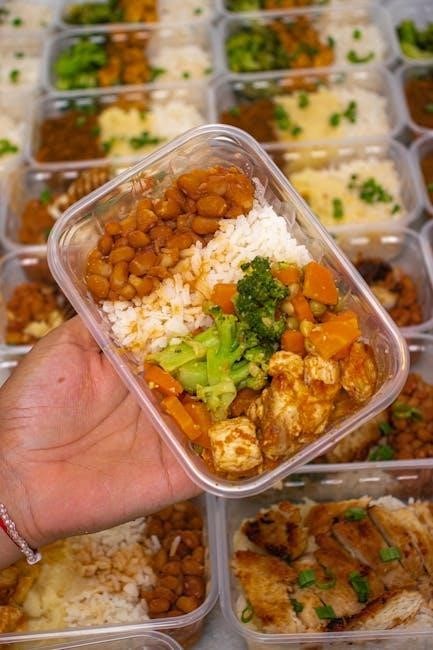What is Carb Cycling?
Carb cycling is a strategic dietary approach that involves varying your carbohydrate intake on different days. It alternates between high-carb days, moderate-carb days, and low-carb days. The goal is to optimize body composition, boost metabolism, and fuel workouts effectively by adjusting carb intake based on activity levels.

Benefits of Carb Cycling
Carb cycling offers several potential advantages, including enhanced metabolic flexibility and improved energy levels. It can aid in weight loss by strategically preventing metabolic adaptation. Moreover, carb cycling provides more dietary flexibility compared to strict ketogenic or very low-carb diets, allowing for adjustments based on individual needs.
Flexibility in Dieting
Carb cycling distinguishes itself through its inherent flexibility, offering a more adaptable approach than rigid dietary regimes like ketogenic or very low-carb diets; This flexibility allows individuals to tailor their carbohydrate intake based on a range of factors, accommodating diverse needs and preferences. Body composition goals, training schedules, and rest days can all be factored in, ensuring the diet aligns with personal objectives.
Scheduled refeeds, special events, or competitions can also be easily integrated, providing a sustainable long-term approach. The type of training and individual body fat levels further influence carb adjustments, promoting a personalized strategy. This adaptability fosters a balanced lifestyle, preventing the restrictive feelings often associated with strict diets. Carb cycling empowers individuals to manage their nutrition effectively while maintaining a degree of freedom and enjoyment, ultimately contributing to greater adherence and long-term success.
The ability to fine-tune carbohydrate intake based on these various factors makes carb cycling a versatile and appealing option for those seeking a sustainable and personalized dietary approach.
Carb Cycling Meal Plan Basics
A carb cycling meal plan strategically alternates between high, moderate, and low-carb days. This approach aligns carbohydrate intake with activity levels, maximizing energy for workouts and promoting fat loss on rest days, focusing on protein, healthy fats, and complex carbs.
High-Carb Days
High-carb days are strategically planned to coincide with your most intense workout days, particularly those focusing on lower body exercises. These days are designed to fuel your body with the necessary energy to maximize performance and support muscle recovery. The increased carbohydrate intake helps replenish glycogen stores depleted during intense physical activity.
On high-carb days, aim for a carbohydrate intake that falls within the range of 35-50% of your total daily calories. Prioritize complex carbohydrates such as oats, quinoa, brown rice, sweet potatoes, and fruits. These options provide sustained energy and essential nutrients. It’s crucial to balance your carbohydrate intake with adequate protein and healthy fats to support overall health and muscle growth.
Timing your carbohydrate intake strategically throughout the day can further enhance the benefits. Consider consuming a portion of your carbohydrates before your workout to fuel your muscles, and another portion after your workout to replenish glycogen stores and promote recovery. Remember to adjust portion sizes based on your individual needs and activity levels.
Low-Carb Days
Low-carb days are strategically incorporated into a carb cycling plan to promote fat loss and enhance insulin sensitivity. These days typically coincide with rest days or days with minimal physical activity. The reduced carbohydrate intake encourages the body to utilize stored fat for energy, leading to weight loss. It’s essential to maintain adequate protein and healthy fat intake on low-carb days to support muscle mass and satiety.
On low-carb days, aim for a carbohydrate intake that falls within the range of 10-20% of your total daily calories. Prioritize non-starchy vegetables such as spinach, broccoli, and asparagus, which provide essential nutrients with minimal carbohydrates. Focus on lean protein sources such as chicken, fish, and tofu, along with healthy fats from avocados, nuts, and seeds.
Careful meal planning is crucial on low-carb days to ensure you meet your nutritional needs while staying within your carbohydrate target. Consider incorporating low-carb recipes that are both satisfying and nutrient-dense. Remember to drink plenty of water throughout the day to support overall health and hydration.
Moderate-Carb Days
Moderate-carb days serve as a bridge between high-carb and low-carb days, providing a balanced approach to fuel your body and maintain energy levels. These days are often scheduled for moderate activity levels or days when you want a slight increase in carbohydrate intake without the full intensity of a high-carb day. The goal is to provide enough carbohydrates to support your activity while still promoting fat loss and metabolic flexibility.
On moderate-carb days, aim for a carbohydrate intake that falls within the range of 20-35% of your total daily calories. Incorporate a mix of non-starchy vegetables, lean protein, healthy fats, and moderate portions of complex carbohydrates such as quinoa, brown rice, or sweet potatoes. These complex carbohydrates provide sustained energy without causing rapid spikes in blood sugar levels.
Careful attention to portion control is essential on moderate-carb days to ensure you stay within your target range. Plan your meals in advance, focusing on nutrient-dense foods that provide both satisfaction and essential vitamins and minerals. Remember to stay hydrated and listen to your body’s cues to adjust your intake as needed.

Sample 7-Day Carb Cycling Meal Plan Structure
A well-structured 7-day carb cycling meal plan provides a framework for strategically manipulating carbohydrate intake throughout the week. The basic structure typically involves alternating between high-carb, moderate-carb, and low-carb days, tailored to match your workout schedule and fitness goals. The key is to align your carb intake with your energy needs on specific days.
A common approach is to schedule high-carb days on your most intense workout days, particularly those focusing on lower body exercises. These days provide the necessary fuel to maximize performance and muscle recovery. Low-carb days are often placed on rest days or days with light activity, encouraging your body to tap into fat stores for energy.
Moderate-carb days can be strategically placed in between high and low-carb days to provide a balanced approach; A typical structure might look like this: Monday (Low-Carb), Tuesday (Moderate-Carb), Wednesday (High-Carb), Thursday (Low-Carb), Friday (Moderate-Carb), Saturday (High-Carb), and Sunday (Low or High-Carb, depending on your goals).
Example Meals for Each Day
To effectively implement a carb cycling plan, understanding example meals for each day is crucial. Each day is different in the amount of carbs, this helps to provide a variety of nutrition and energy based on the cycling program.
Low Carb Day Sample Meal
On low-carb days, the focus shifts to meals rich in protein and healthy fats, limiting carbohydrate intake to 10-20%. A sample breakfast could be scrambled eggs with spinach and avocado. This provides essential nutrients and keeps you feeling full.
For lunch, consider a large salad with grilled chicken or fish, olive oil, and mixed greens. This combination offers protein and healthy fats while keeping carbs low. A mid-afternoon snack could be a handful of almonds or a small serving of cottage cheese.
Dinner on a low-carb day might include baked salmon with steamed broccoli and a side of asparagus. Salmon is an excellent source of omega-3 fatty acids and protein. Staying hydrated is also crucial, so drink plenty of water throughout the day.
Remember to adjust portion sizes to meet your individual caloric needs and macros. These low-carb meal options help maintain energy levels and support fat loss goals while adhering to the principles of carb cycling.
Medium Carb Day Sample Meal
Medium-carb days strike a balance, incorporating 20-35% of calories from carbohydrates. A sample breakfast could be Greek yogurt with berries and a sprinkle of nuts. This meal provides a good mix of protein, healthy fats, and moderate carbs to start the day.
For lunch, consider a turkey breast sandwich on whole-grain bread with lettuce, tomato, and avocado. Whole-grain bread offers complex carbohydrates for sustained energy. A mid-afternoon snack could be an apple with peanut butter, combining fiber and protein.
Dinner on a medium-carb day might include grilled chicken breast with quinoa and steamed green beans. Quinoa is a complete protein and provides complex carbohydrates. Ensure portion sizes align with your daily caloric targets.
Throughout the day, include plenty of water and adjust the meal composition based on your physical activity. The goal is to maintain a balanced approach, supporting energy needs while still managing carbohydrate intake effectively. This approach is key to successful carb cycling.
High Carb Day Sample Meal
On high-carb days, which typically coincide with intense workout days, the goal is to replenish glycogen stores. A sample breakfast might include oatmeal with fruit and a scoop of protein powder to kickstart the day. Oatmeal provides sustained energy from complex carbohydrates.
For lunch, a sweet potato with black beans, salsa, and a dollop of Greek yogurt offers a balanced combination of carbs, protein, and healthy fats. An afternoon snack could be a banana with almond butter to maintain energy levels.
Dinner could consist of grilled salmon with brown rice and roasted vegetables. Brown rice is a complex carbohydrate source, and salmon provides essential omega-3 fatty acids.
Hydration is crucial, so drink plenty of water throughout the day. Adjust portion sizes according to your individual caloric and macro targets. This strategy ensures that your body has ample fuel for workouts while supporting recovery and muscle growth. This approach is vital for effective carb cycling and optimal performance.

Free Carb Cycling Meal Plan PDF Resources
Numerous free carb cycling meal plan PDF resources are available online to help individuals navigate this dietary strategy effectively. These resources typically include sample meal plans, recipes, and shopping lists designed for high, moderate, and low-carb days. Many of these PDFs offer customizable templates.
These resources often provide guidance on calculating macronutrient targets based on individual goals, activity levels, and body composition. They also offer tips on food swaps and portion control, allowing for flexibility and personalization. Some PDFs include educational content on the principles of carb cycling, explaining the rationale behind alternating carb intake.
Users can find these resources on various fitness and nutrition websites, blogs, and forums. Downloading a free carb cycling meal plan PDF can be a valuable starting point for those new to this approach, providing a structured framework to follow and adapt as needed. They aid in organizing your diet, so you can stay on track.

12-Week Carb Cycling Meal Plan PDF
A 12-week carb cycling meal plan PDF provides a structured and comprehensive approach to implementing this dietary strategy over an extended period. This type of resource typically includes detailed meal plans for each week, outlining specific foods and portion sizes for high, moderate, and low-carb days. This allows for long term planning.
The PDF often includes a variety of recipes to keep meals interesting and prevent dietary boredom. It may also offer guidance on adjusting the meal plan based on individual progress and goals. Shopping lists are frequently included to simplify grocery shopping and ensure adherence to the plan.
A 12-week plan allows for a more gradual and sustainable approach to carb cycling, enabling individuals to monitor their progress and make necessary adjustments along the way. These PDFs are great for those who are serious about carb cycling and want to ensure they are following a well thought out plan. They can be found online.
